Dear Zazie,
Here is today’s Lovers’ Chronicle from Mac Tag.
Rhett
The Lovers’ Chronicle
Dear Muse,
another of uncertain origin
for the one not found
“Well, at that point”
oh yes, that was pre-you
“I thought you were going
to say, it was about a girl”
they are all about a girl
from the one not found,
to friends and at last,
of, for and about you
the one that fills
every need
© copyright 2023 mac tag/cowboycoleridge all rights reserved
round and round on this one
not how i saw things playin’ out
Jimmy sang about rollin’ with the punches
and Jerry Jeff about just lettin’ it roll
either works as for how and why
you were gonna ask that, right
that is the best i can do
when someone knows
absolutely
what they want
and how to get it
well, there you have it
© copyright 2022 mac tag/cowboycoleridge all rights reserved
never anything
more important
wiser than
any experience,
those moments
with you
normal
has left the buildin’
and ordinary
those things
have no meanin’
no place
ever
not since
this vision
this inspiration
of you
© copyright 2021 mac tag/cowboycoleridge all rights reserved
© copyright 2020 mac tag/cowboy coleridge all rights reserved
a dream of which
this can be asked
cuttin’ up dead,
felled trees
in our forest
then draggin’ ’em
to the burn pile
that night,
together
watchin’ the flames
and sparks dance
in the darkness
what we made
by the fire
in the forest,
then
the fire
in the forest
© copyright 2019 mac tag/cowboy coleridge all rights reserved
the one who never was
wherefore art thou
ha, no need for that
just stay right here
focus on creatin’
this is the one
anything else
would be mere distraction
no point in bein’ beatin’
further about the head
not meant to be
is not meant to be
of you, yes you
and stayin’ that way
© copyright 2018 mac tag/cowboy coleridge all rights reserved
no longer upon work
or the Appaloosa,
does his talk seem to run,
or anything recent,
just her
she flowin’ly merges
with whatever scene
he is inventin’ or livin’ again,
as he wanders unendin’ly
in the world he dreams in
© copyright 2016 Mac Tag all rights reserved
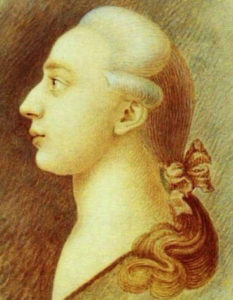 Today is the birthday of Giacomo Casanova (Giacomo Girolamo Casanova; Venice 2 April 1725 – 4 June 1798 Dux, Bohemia, Holy Roman Empire (Czech Republic)), an Italian adventurer and author. His autobiography, Histoire de ma vie (Story of My Life), is regarded as one of the most authentic sources of the customs and norms of European social life during the 18th century. He has become so famous for his often complicated and elaborate affairs with women that his name is now synonymous with “womanizer”.
Today is the birthday of Giacomo Casanova (Giacomo Girolamo Casanova; Venice 2 April 1725 – 4 June 1798 Dux, Bohemia, Holy Roman Empire (Czech Republic)), an Italian adventurer and author. His autobiography, Histoire de ma vie (Story of My Life), is regarded as one of the most authentic sources of the customs and norms of European social life during the 18th century. He has become so famous for his often complicated and elaborate affairs with women that his name is now synonymous with “womanizer”.
For Casanova, as well as his contemporary sybarites of the upper class, love and sex tended to be casual and not endowed with the seriousness characteristic of the Romanticism of the 19th century. Flirtations, bedroom games, and short-term liaisons were common among nobles who married for social connections rather than love.
Although multi-faceted and complex, Casanova’s personality, as he described it, was dominated by his sensual urges: “Cultivating whatever gave pleasure to my senses was always the chief business of my life; I never found any occupation more important. Feeling that I was born for the sex opposite of mine, I have always loved it and done all that I could to make myself loved by it.” He noted that he sometimes used “assurance caps” to prevent impregnating his mistresses.
Casanova’s ideal liaison had elements beyond sex, including complicated plots, heroes and villains, and gallant outcomes. In a pattern he often repeated, he would discover an attractive woman in trouble with a brutish or jealous lover (Act I); he would ameliorate her difficulty (Act II); she would show her gratitude; he would seduce her; a short exciting affair would ensue (Act III); feeling a loss of ardor or boredom setting in, he would plead his unworthiness and arrange for her marriage or pairing with a worthy man, then exit the scene (Act IV). As William Bolitho points out in Twelve Against the Gods, the secret of Casanova’s success with women “had nothing more esoteric in it than [offering] what every woman who respects herself must demand: all that he had, all that he was, with (to set off the lack of legality) the dazzling attraction of the lump sum over what is more regularly doled out in a lifetime of installments.”
Casanova advises, “There is no honest woman with an uncorrupted heart whom a man is not sure of conquering by dint of gratitude. It is one of the surest and shortest means.” For him, attentiveness and small favors should be employed to soften a woman’s heart, but “a man who makes known his love by words is a fool“. Verbal communication is essential—”without speech, the pleasure of love is diminished by at least two-thirds“—but words of love must be implied, not boldly proclaimed.
Mutual consent is important, according to Casanova, but he avoided easy conquests or overly difficult situations as not suitable for his purposes. He strove to be the ideal escort in the first act—witty, charming, confidential, helpful—before moving into the bedroom in the third act. Casanova claims not to be predatory (“my guiding principle has been never to direct my attack against novices or those whose prejudices were likely to prove an obstacle“); however, his conquests did tend to be insecure or emotionally exposed women.
Casanova valued intelligence in a woman: “After all, a beautiful woman without a mind of her own leaves her lover with no resource after he had physically enjoyed her charms.”
Histoire de ma vie (Story of My Life) is his memoir and autobiography. A previous, bowdlerized version was originally known in English as The Memoirs of Jacques Casanova (from the French Mémoires de Jacques Casanova) until the original version was published in 1960.
From 1838 to 1960, all the editions of the memoirs were derived from the bowdlerized editions produced in German and French in the early nineteenth century. Although Casanova was Venetian, the book is written in French, which was the dominant language in the upper class at the time. The book covers Casanova’s life only through 1774, although the full title of the book is Histoire de ma vie jusqu’à l’an 1797 (History of my Life until the year 1797).
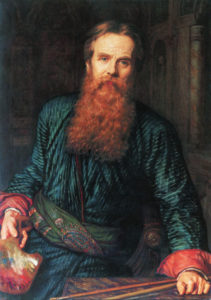 Today is the birthday of William Holman Hunt (Cheapside 2 April 1827 – 7 September 1910 Kensington), an English painter and one of the founders of the Pre-Raphaelite Brotherhood.
Today is the birthday of William Holman Hunt (Cheapside 2 April 1827 – 7 September 1910 Kensington), an English painter and one of the founders of the Pre-Raphaelite Brotherhood.
His paintings were notable for their great attention to detail, vivid colour, and elaborate symbolism. These features were influenced by the writings of John Ruskin and Thomas Carlyle, according to whom the world itself should be read as a system of visual signs. For Hunt it was the duty of the artist to reveal the correspondence between sign and fact. Of all the members of the Pre-Raphaelite Brotherhood, Hunt remained most true to their ideals throughout his career. He was always keen to maximise the popular appeal and public visibility of his works.
Hunt married twice. After a failed engagement to his model Annie Miller, he married Fanny Waugh, who later modelled for the figure of Isabella. When she died in childbirth in Italy, he sculpted her tomb at Fiesole, having it brought down to the English Cemetery in Florence, beside the tomb of Elizabeth Barrett Browning. He had a close connection with St. Mark’s Church in Florence, and paid for the communion chalice inscribed in memory of his wife. His second wife, Edith, was Fanny’s sister. At the time it was illegal in Great Britain to marry one’s deceased wife’s sister, so Hunt travelled abroad to marry her. This led to conflict with other family members, notably his former Pre-Raphaelite colleague Thomas Woolner, who had once been in love with Fanny and had married Alice, the third sister of Fanny and Edith.
Hunt died on 7 September 1910 and was buried in St Paul’s Cathedral in London, England.
Gallery
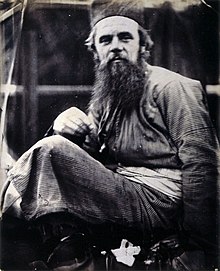
Hunt in his eastern dress, photo by Julia Margaret Cameron

The Awakening Conscience (1853)
| Max Ernst | |
|---|---|

1920, Punching Ball ou l’Immortalité de Buonarroti, photomontage, gouache, ink on photograph (self-portrait)
|
|
Today is the birthday of Max Ernst (Brühl, German Empire 2 April 1891 – 1 April 1976 Paris); painter, sculptor, graphic artist, and poet. A prolific artist, Ernst was a primary pioneer of the Dada movement and Surrealism.
In 1918 he married art history student Luise Straus, whom he had met in 1914. Ernst’s marriage to Luise was short-lived. In 1921 he met Paul Éluard, who became a close lifelong friend. Éluard bought two of Ernst’s paintings (Celebes and Oedipus Rex) and selected six collages to illustrate his poetry collection Répétitions. A year later the two collaborated on Les malheurs des immortels, and then with André Breton, whom Ernst met in 1921, on the magazine Littérature. In 1922, unable to secure the necessary papers, Ernst entered France illegally and settled into a ménage à trois with Éluard and his wife Gala in Paris suburb Saint-Brice, leaving behind his wife and son.
In 1924 Éluard left, first for Monaco, and then for Saigon, Vietnam. He soon asked his wife and Ernst to join him. After a brief time together in Saigon, the trio decided that Gala would remain with Paul. The Éluards returned to Eaubonne in early September, while Ernst followed them some months later. He returned to Paris in late 1924 and established a studio at 22, rue Tourlaque.
In 1927 Ernst married Marie-Berthe Aurenche, and it is thought his relationship with her may have inspired the erotic subject matter of The Kiss and other works of that year. Ernst appeared in the 1930 film L’Âge d’Or, directed by self-identifying Surrealist Luis Buñuel. In 1938, the American heiress and artistic patron Peggy Guggenheim acquired a number of Ernst’s works, which she displayed in her new gallery in London. Ernst and Guggenheim later were married (1942–1946).
In September 1939, the outbreak of World War II caused Ernst to be interned as an “undesirable foreigner” in Camp des Milles, near Aix-en-Provence. At the time, he was living with his lover and fellow surrealist painter, Leonora Carrington who, not knowing whether he would return, saw no option but to sell their house to repay their debts and leave for Spain. Thanks to the intercession of Éluard and other friends, he was released a few weeks later. Soon after the German occupation of France, he was arrested again, this time by the Gestapo, but managed to escape and flee to America with the help of Guggenheim and friends. Ernst and Guggenheim arrived in the United States in 1941 and were married at the end of the year.
His marriage to Guggenheim did not last and in Beverly Hills, California in October 1946, in a double ceremony with Man Ray and Juliet P. Browner, he married Dorothea Tanning.
The couple made their home in Sedona, Arizona from 1946 to 1953, where the high desert landscapes inspired them and recalled Ernst’s earlier imagery. Despite the fact that Sedona was remote and populated by fewer than 400 ranchers, orchard workers, merchants and small Native American communities, their presence helped begin what would become an American artists colony. Among the monumental red rocks, Ernst built a small cottage by hand on Brewer Road and he and Tanning hosted intellectuals and European artists such as Henri Cartier-Bresson. Sedona proved an inspiration for the artists and for Ernst, who compiled his book Beyond Painting and completed his sculptural masterpiece Capricorn while living there. From the 1950s he lived mainly in France. He died at the age of 84 on 1 April 1976 in Paris, and was interred at Père Lachaise Cemetery.
Gallery
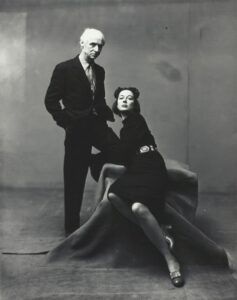
Ernst & Tanning, New York, 1947.
© Irving Penn
(Art institute of Chicago)
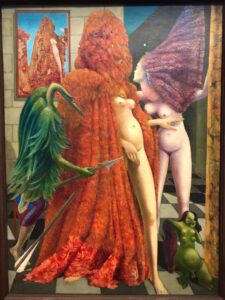
The robing of the bride
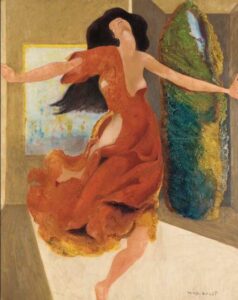
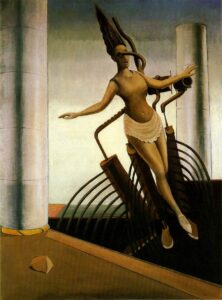
Wavering Woman
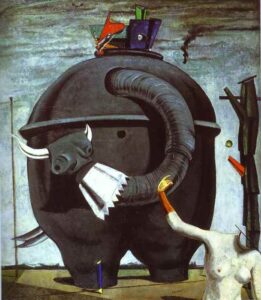
The Elephant Celebes. Oil on canvas. 125.4 x 107.9 cm. Tate Gallery, London

Ubu Imperator, (1923), Musee National d’Art Moderne, Centre Pompidou, Paris, France

L’Ange du Foyer, (1937)
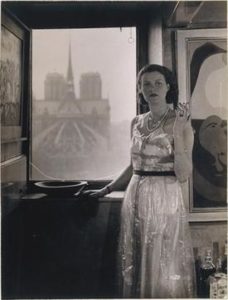
Peggy Guggenheim, c.1930, Paris, photograph Rogi André (Rozsa Klein). In the background, Notre Dame de Paris, and on the right, Joan Miró, Dutch Interior II (1928)
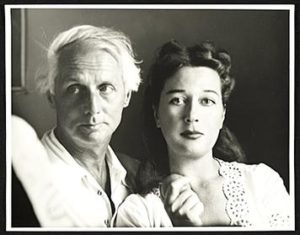
Ernst and Tanning
- Etna
- Grave-digger
- at your post for thirty years
- like Jesus Christ
- you seldom grant yourself…
- fully content with a little exercise
- exercise makes you strong
- I like you
- first couplet of his poem ‘Etna’, in: ‘Literature’, Paris, October 15, 1923; as quoted in Max Ernst sculpture, Museo d’arte contemporanea, Edizioni Charta, Milano, 1969, p. 15
- What is a dream? You ask too much of me: it is a woman cutting down a tree. What are forests for? For making the matches one gives children to play with. Is the fire in the forest, then? The fire is in the forest. What do plants feed on? On mystery. What day is it today? Shit..
- A painter may know what he doesn’t want. But woe be to him if he desires to know what he wants. A painter is lost if he finds himself. Max Ernst considers his sole virtue to be that he has managed not to find himself.
- In Beyond Painting, Max Ernst, 1948, p.14; as quoted in Max Ernst: a Retrospective, ed. Werner Spies & Sabine Rewald, Metropolitan Museum of Art, New York 2005, p. 6
- Woman’s nakedness is wiser than the teachings of the philosophers. [the title of his essay]
- In: Max Ernst, Gonthier-Seghers, Paris, 1959; as quoted in Max Ernst sculpture, Museo d’arte contemporanea. Edizioni Charta, Milano, 1996, p. 37
- A painter may know what he does not want.
- But woe betide him if he wants to know
- what he does want! A painter is lost if he finds himself.
- The fact that he has succeeded in not finding
- himself is regarded by Max Ernst as his only
- ‘achievement’.
- Max Ernst in ‘Max Ernst’, exhibition catalogue, Galerie Stangl, Munich, 1967, U.S., pp.6-7, as quoted in Edward Quinn, Max Ernst. 1984, Poligrafa, Barcelona. p. 12
‘Ecritures’ (1970)
- ‘Écritures’ pp. 221, 223., as quoted in Max Ernst, Edward Quinn, Poligrafa, Barcelona, 1984,
- Eternity
- Hide yourself
- eternity
- beloved eternity
- p.290
- The painter
- The painter allows you not to know
- what a face is
- Escaped from the museum of man,
- he has chosen to be mortal!
- Mortal like
- the kiss of the Mona Lisa
- p. 352
- Laymanship
- Don’t confuse
- the fairy’s kiss
- with
- the priest’s spanking
- p. 360
- Sanctuary
All windows fall silent The earth closes its eyes
- p. 366
Mac Tag




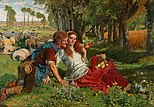






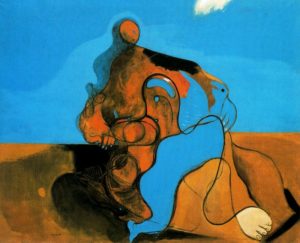
No Comments on "The Lovers’ Chronicle 2 April – of you – birth of Casanova – art by William Holman Hunt – art and verse by Max Ernst"